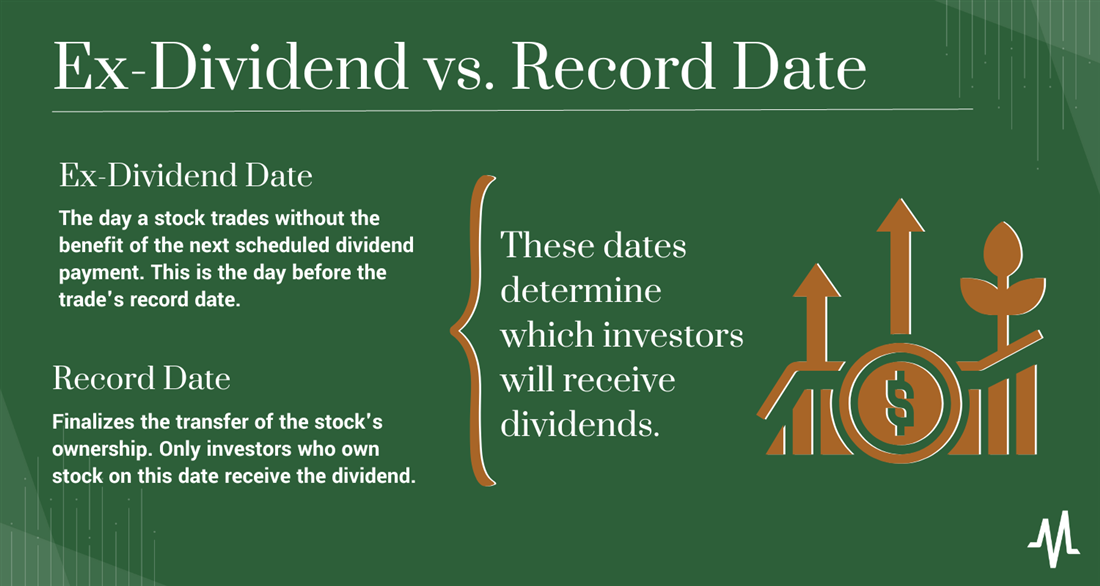When investing for dividends, a vital sequence to understand is the ex dividend date vs record date. To be entitled to a company's dividend payout, an investor must hold shares through a specific day, which will vary depending on the company. Investors with long time horizons using "buy and hold" strategies don't need to be too concerned with these dates, but day and swing traders must understand them to maximize returns.
In this article, you'll learn the difference between the two most decisive dates on the dividend calendar: the ex-dividend date vs. the record date. You'll also learn why these dates are set the way they are and how to leverage the calendar for specific dividend investment strategies.
Overview: Ex-Dividend Date and Record Date
Dividends make up a substantial portion of annual stock returns. Of course, the total dividend contribution varies yearly, and today, companies pay out fewer dividends than they did in the 1960s and 1970s.
But during the decade lasting from 2010 to 2020, dividends still accounted for 17% of the S&P 500's total return. Compound interest is a powerful force — combining it with dividend reinvestment is like feeding performance enhancers to an Olympian.
However, owning a company's stock doesn't necessarily entitle you to its dividend. Instead, you must own the stock at a specific time to earn the dividend, which is why you'll see a feature like a dividend calendar on your brokerage account. The dividend calendar breaks into a few critical dates — always beware of these if you're frequently trading.

Ex-Dividend Date
What is the ex dividend date?
Imagine the ex-dividend date like it's the Super Bowl for dividends. You can attend the game if you purchase a ticket to the Super Bowl before kickoff. It doesn't matter if you bought your tickets two months ago or two days ago — as long as you have them by the start of the game, you can get in.
The ex-dividend date works similarly, and your shares are the tickets. You'll get the dividend payment if you own shares at least one day before the ex-dividend date. If you buy shares on or after the ex-dividend date, you won't get the dividend from that particular quarter. You don't need to hold your shares through the ex-dividend date. You'd get the dividend if you were on record as a shareholder before the close of the preceding market session. Note that if you sell your shares before the end of the session, the person who acquires and holds them through close will get the dividend.
Record Date
The record date is less important than the ex-dividend date. On the record date, the company makes a note of eligible dividend recipients on their books. The record date usually comes two days after the ex-dividend date, so all stock trades can settle and give the company full scope of who owned stock before the cutoff. Investors can note the record date on their calendars, but it's merely a company bookkeeping day for the executives.
Other Important Dates
Each quarterly dividend calendar will have four particular dates of interest to investors. The ex-dividend date is the big one, but you should also be aware of these two other dates when using dividend investing strategies:
- Declaration date: The first entry on the dividend calendar is the declaration date, which usually occurs at least a week before the ex-dividend date. On the declaration date, the company's board sits down and determines how much of its quarterly net profits will return to shareholders. Once the board decides, the company announces it, so shareholders know their dividend payout.
- Payout date: Finally, investors get shown the money. The payout date is when dividend payments arrive in the brokerage accounts of eligible shareholders. Dividends are usually paid out in cash, although many companies have an option for shareholders to reinvest their dividends back into the stock automatically.
Record Date vs. Ex-Dividend Date Example
Here's an example of how the ex-dividend date vs. record date works. Let's say you want to purchase shares in Procter & Gamble Co. (NYSE: PG), the consumer goods giant that has raised its dividend payouts for more than 65 straight years. You'll want to find companies with solid dividend payouts using strategies like dividend capture.
In this hypothetical scenario, imagine Procter & Gamble has the following dividend calendar:
- Declaration date: Monday, March 6
- Ex-dividend date: Monday, March 13
- Record date: Wednesday, March 15
- Payout date: Monday, April 10
Once the dividend has been declared, you can decide if the shares are worth owning to entitle yourself to that dividend. To get the dividend, you must own shares by the close of the trading day before the March 13 ex-date. But since the ex-date is a Monday, you'll need to hold the shares by the end of the previous session on Friday, March 10. The seller will receive the dividend if you wait and buy shares on the ex-dividend date.
After purchasing shares on Friday, March 10, you can sell them as early as the following Monday. You'll get the dividend on the payout date if you own them through the previous session's close. You can choose to sell the shares on the ex-dividend date or continue holding them, whatever your investment strategy dictates. Also, remember that dividends count as ordinary income, so always have a plan for taxes when investing.
On April 10, you'll receive your dividend payment, even if the shares that entitled you to it have long been sold. You can use your income dividends or reinvest them into the stock.
Note: Use MarketBeat's dividend screener to search for yields, payouts and dates.
Who Sets the Ex-Dividend Date?
The stock exchanges, not the individual public companies, give the ex dividend date meaning. The firm issuing the stock manages the declaration date, record date and payout date, but the exchange sets the ex-dividend date.
In the example above, Procter & Gamble had a declaration date of March 6 and a record date of March 15. In this scenario, the New York Stock Exchange (NYSE) would set the ex-dividend date for March 13 to allow time for trade settlement. The NYSE sets most ex-dividend dates and other exchanges follow in lockstep.
When to Buy Shares to Get Dividends
You can sit on your shares and collect your dividends if you're a buy-and-hold investor. As mentioned above, dividend reinvestment contributes significantly to an investor's returns over time. Many investors approaching retirement age choose companies from the Dividend Aristocrats or Dividend Champions lists for their steadily increasing payouts. (Plus, these stocks tend to be less volatile than the overall market.)
But if you want to swing trade stocks for dividends, you'll need to hold through the close of the trading session before the ex-dividend date. This is the only day that matters. If the ex-dividend date is May 7, you must own the shares when the May 6 trading session ends.
As a result, investors only need to hold shares overnight for a single day to get the payout. This rule extends into the after-hours period, which ends at 8 p.m., meaning you can purchase shares at 7:59 p.m., sell them at 9:30 a.m. the following day and still get the dividend.
How Many Days Are Between the Ex-Dividend and Record Dates?
Two different entities set the ex-dividend date and record date. First, a public company will announce a dividend and inform investors when the record date and payout date will occur. Once established, the exchange (usually the New York Stock Exchange) will set an ex-dividend date as a cutoff for dividend eligibility.
In most instances, the ex-dividend date will be two days before the record date, providing brokers time to settle stock trades. Of course, the ex-dividend date doesn't necessarily need to be two days before the record date, but this is the preferred timeframe of the New York Stock Exchange, and most other exchanges follow their lead.
Is the Record Date or the Ex-Dividend Date More Important?
For investors, the ex-dividend date vs. record date battle is no contest — the ex-dividend date is the most important day on the dividend calendar. If you're investing for dividends, you must maintain awareness of the ex-dividend date since investors must own shares before it arrives. On the other hand, the record date is more important for the company issuing the dividend since that's when qualified recipients are documented.
Note Specific Dates When Dividend Investing
The dividend calendar has plenty of entries, and novice investors may need clarification as to which dates matter more for their purposes. For example, the record date may sound more important, but insignificant to investors. Instead, the ex-dividend date is critical since it marks the cutoff for dividend eligibility.
Buying shares on or after the ex-dividend date won't entitle you to a dividend; you must own stock by the time the bell rings to close the trading session before the ex-dividend date. However, selling stock before the ex-dividend date can also negate your payout if you fail to hold through the close the day before. So if you're frequently trading, keep these rules in mind to maximize your dividends and make the most of your returns.
FAQs
Here are a few frequently asked questions regarding the ex-dividend date vs. record date.
Can you sell on the record date and still get the dividend?
Yes, you can sell anytime on or after the ex-dividend date and still be eligible for the dividend. All investors who owned stock by the end of the trading session the day before the ex-dividend date will receive the payout.
Will I get the dividend if I buy on the ex-date?
Oh, the dividend date record date debate. No, the ex-dividend date is the first day the company trades without a shareholder entitled to the dividend. Therefore, investors must own shares the day before the ex-dividend date for dividend eligibility.
What are the three important dates for dividends?
The three most important dates on the dividend calendar are the ex-dividend date, the record date and the payment date.
What is ex-dividend date? The ex-dividend date marks the dividing line between dividend eligibility; the record date is when shareholders earning dividends are observed and the payment date is when the dividend distributes to eligible shareholders.




